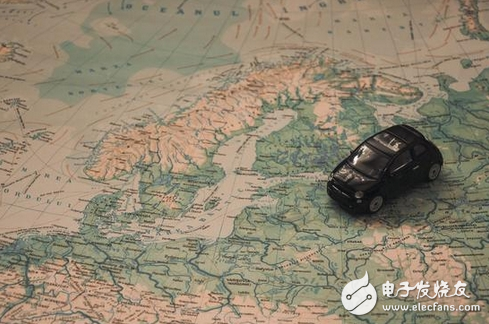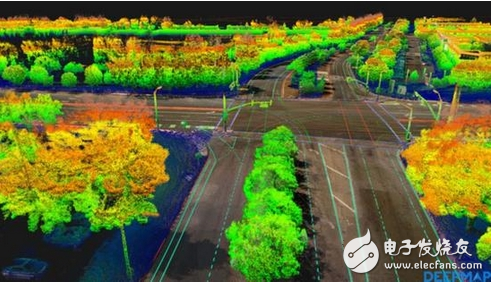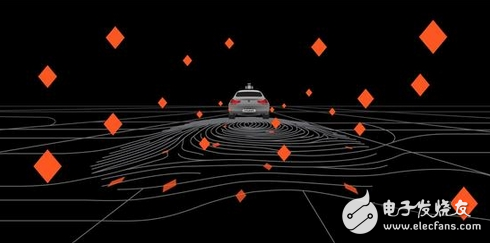Google's map project focuses on so-called driver assistance systems to enable cars to automate some of their driving functions and help them see what's going on the road or corner. An early version of the "vehicle map service" released by Google in December merged sensor data into their maps. Currently, Google is offering the service to automakers using Google's in-car embedded operating system, Android AutomoTIve.

On February 24th, in the field of consumer digital maps, Google is the undisputed winner. Today, driverless cars also need high-resolution maps that cover detailed data of the streets. This time no one in the industry would like to see Google laugh again. . This map battle is in full swing, and many companies are competing.
No matter what day, Silicon Valley may have more than a dozen driverless cars drawing maps on the same street corner. These cars are from different companies, but do the same thing: making high-precision street maps. These maps may eventually become car navigation guides for unmanned vehicles.
These companies are concentrated in places where the legal and weather environment is favorable – or where they can get the most attention. For example, a group of surveying vehicles gather around the CES (International Consumer Electronics Show) in Las Vegas every year because it is a hot stage to showcase the technical achievements of autonomous vehicles. Chris McNally, an analyst at Evercore ISI, said, "There may be 50 companies that are rushing to map maps of Las Vegas just to provide people with driverless car trials during CES. This is really a waste of resources."
Self-driving cars require powerful sensors to inspect the surrounding environment, as well as advanced software to think and make decisions. They especially need the latest map of every conceivable road to drive. Whoever has the most detailed and extensive map for the vehicle to read will have an asset worth billions of dollars.
Because of this, a map war is in full swing: dozens of competitors enter a dazzling array of alliances, tens of millions of dollars in investment to seek huge returns that may come in a few years. Alphabet's Google became the undisputed winner in consumer digital maps in the early years. With Google Maps, human drivers can avoid peak traffic or find restaurants. How did Google win? It has sent maps and carts across the globe, and it has software expertise that map navigation companies, car manufacturers and even Apple can't match. No one wants Google to win again.
So companies involved in auto-driving vehicle maps are taking two different strategies, one of which is to create a complete high-precision map that allows future driverless cars to drive completely independently; the other is to create them bit by bit. The map, which uses the sensors on the vehicle, allows the car to gradually increase the degree of automatic driving.

Alphabet is taking both strategies at the same time. According to four people familiar with the matter, a team inside Google is developing a 3D map project that may be licensed to automakers. This map service is different from the high-precision map that Waymo, another subsidiary of Alphabet, created for its self-driving vehicles.
Google's map project focuses on so-called driver assistance systems to enable cars to automate some of their driving functions and help them see what's going on the road or corner. An early version of the "vehicle map service" released by Google in December merged sensor data into their maps.
Currently, Google is offering the service to automakers using Google's in-car embedded operating system, Android AutomoTIve. So far, Google has developed three partners for the system, but other automakers are reluctant to hand over their center console to the search giant. Therefore, according to people familiar with the matter, Google is looking to expand the capabilities of the map service and look for other distribution methods.
A Google spokesperson said in a statement, "We have built a comprehensive world map for people, and we are working hard to expand the usability of our maps for cars." She declined to comment on future plans.
At the same time, Waymo and other giants with large unmanned research teams, including General Motors, Uber and Ford Motor Company, have sent their own fleets to create rich, detailed precision for driverless cars. map. There are also smaller start-ups that sell equipment or proprietary software that makes such maps to automakers who feel they are far behind others. There are also a number of vendors that are creating map services for ordinary cars, but these services have only a few automation features, such as adaptive cruise control or night vision.
These self-driving car maps are much more demanding than older digital maps, which has led to huge investments in Detroit, Silicon Valley and China. “Autonomous cars want maps to be as accurate, accurate, and real-time as possible,†says Bryan Salesky, who led the startup Argo AI, which was founded a year ago. “The ready-made solution doesn’t exist.†Argo AI has received a $1 billion investment from Ford.
Cartographic weapon dealerMaking a driverless car map is a daunting task, just like building a driverless car. An unmanned test fleet loaded with expensive lidar sensors and cameras is deployed with human drivers to capture the surrounding environment. Drawing the results will help train the next team, which will still be equipped with a safety driver – in some cases, dozens of people will be sitting in front of the computer to classify all the cameras.
This is a costly test, and it will take years to get a return, if not decades later. “Even if you can drive your own vehicle and be able to drive on every road in the world, how do you update it?†Mobileye spokesperson Dan Galves asked, “You have to be again Send these survey vehicles."
Unlike traditional digital maps, autonomous driving car maps require almost constant updates. Even subtle changes on the road—the building areas that rise from the ground overnight, or a little bit of debris—can affect the driving of driverless cars. "After a weird thing, driverless cars can't function properly," analyst McNally said.
Mobileye believes that it is more efficient and cost-effective for the cars we drive today to see the road ahead. In January, Intel announced a "low bandwidth" map mapping project that plans to push its front-facing camera and chip sensors to 2 million vehicles this year. The company's idea is to allow cars to see information such as lane markings, traffic signals, and road boundaries, allowing them to automate some of them.
Mobileye said that this demand for computing power is less than building a comprehensive road high-precision map; Mobileye's Graves said that the company will match its sensor data with the map of the navigation company and gradually create a fully self-driving car. A map that can be used.

This is also the strategy adopted by Google's long-standing map competitors HERE and TomTom NV. The two European companies have positioned themselves as a major replacement for Google Maps, focusing on the sale of center console maps to automakers. However, these "static" maps only see rough street conditions and capture real-time snapshots. Both companies are now developing alternatives: “dynamic†maps that show lanes, roadsides and anything else on the road. They hope that automakers will stick to the traditional map maker's products while the car is transitioning from an intelligent vehicle to a fully-automated vehicle without a steering wheel.
HERE, owned by a consortium of German car manufacturers, provides some examples. Its map system brings limited hands-free driving to one of its co-owners, Audi, and will also provide security support for another co-owner, BMW, this year. Intel also acquired a 15% stake in HERE last year.
Tesla, the provider of assisted driving software Autopilot, is the most eager car company to embrace the gradual approach to autonomous driving. Tesla relies on cameras and sensors on the vehicle, but does not use lidar. The company has not disclosed which map service its Autopilot will use, and its company representatives declined to comment. Tesla was unhappy with Mobileye two years ago and stopped working together.
However, Tesla has chosen at least another company, Mapbox, to help integrate the map. Based on the regulatory filings it submitted, Tesla paid Mapbox a $5 million two-year license fee in December 2015. Mapbox mainly sells its location data to applications such as Pinterest and Snapchat. After a recent round of financing of $164 million, the company began to get involved in car maps. According to Mapbox, it installs about 220 million miles of road data globally through software installed on mobile phones, providing an up-to-date snapshot of basic conditions such as street and street.
Eric Gundersen, the startup’s chief executive, said, “The number of sensors we’re on the road is now more than the total number of sensors in the connected car industry by 2020.†For automakers Mapbox's selling point is to use its location data as the base layer for future maps - pair it with camera systems (like from Mobileye) or their own sensor data. Like other companies that target automakers, Mapbox is willing to play a neutral role and is willing to work with anyone. "We don't know who will win," Gunderson said.
A new generation of pathfindersUnknown is not only who will laugh at the end, the map mapping industry does not even know which strategy is better, each autonomous car map looks different, because different sensor systems, the vehicle will produce different maps . Nabeel Hyatt, an early investor at Cruise AutomaTIon from Spark Capital, points out that there are no standard sensor packages in the field. Cruise AutomaTIon is a self-driving car company that was bought by General Motors in 2016 for $580 million.
Therefore, a group of high-precision mapping companies are making different attempts on this issue. They are all favored by venture capital and are also striving for lucrative contracts. Some of the companies are not convinced of Mobileye's strategy, which relies on a seamless transition from semi-automatic driving (so-called Level 2 and Level 3) to driverless driving (Level 4 or Level 5). “It’s very difficult to climb from level 2 to level 3 and then to level 4,†said Wei Luo, chief operating officer of DeepMap. “The gap is very large.†He believes that the best is high. The accuracy map is built around the unmanned features. The startup said it is working with Ford, Honda and China's SAIC, and Mobileeye is also working with SAIC, and Waymo is negotiating with Honda.
The ultra-thin precision cutting of the Anti-Peep Screen Protector means that you can enjoy a perfect touch screen experience without allowing anything on the screen to be peeped. Whether you place your phone horizontally or vertically, Privacy Screen Protector can protect your personal Information and sensitive information are protected from harm by strangers. People around you cannot see the contents of your phone, so your details are safe.
The use of soft TPU material can really cover the entire screen.
With self-healing function, it can automatically repair bubbles and scratches within 24 hours.
The 0.14mm Ultra-Thin Protective Film can maintain the sensitivity of the touch screen to accurately respond to your touch.
The oleophobic and waterproof coating prevents fingerprints, oil stains and other substances from adhering to it and keeps the screen clean.
If you want to know more about Privacy Screen Protector products, please click Product Details to view the parameters, models, pictures, prices and other information about Privacy Screen Protector products.
Whether you are a group or an individual, we will try our best to provide you with accurate and comprehensive information about Privacy Screen Protector!
Anti-Spy Hydrogel Screen Protector, Privacy Protection Film, Protection Film, Privacy Film, Privacy Screen Protective Film, Soft Film
Shenzhen Jianjiantong Technology Co., Ltd. , https://www.hydrogelprotectivefilm.com
